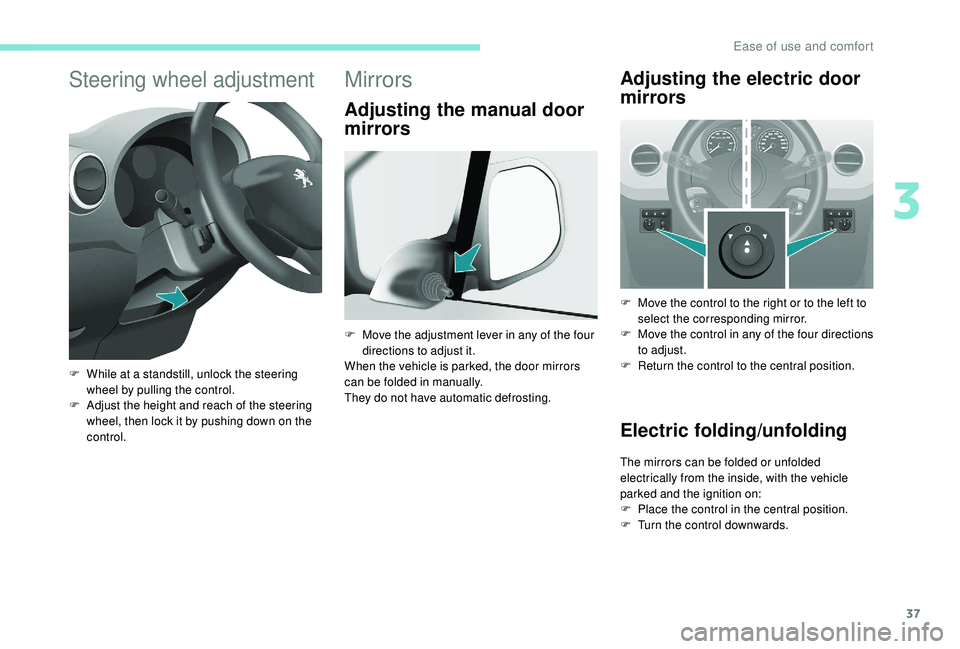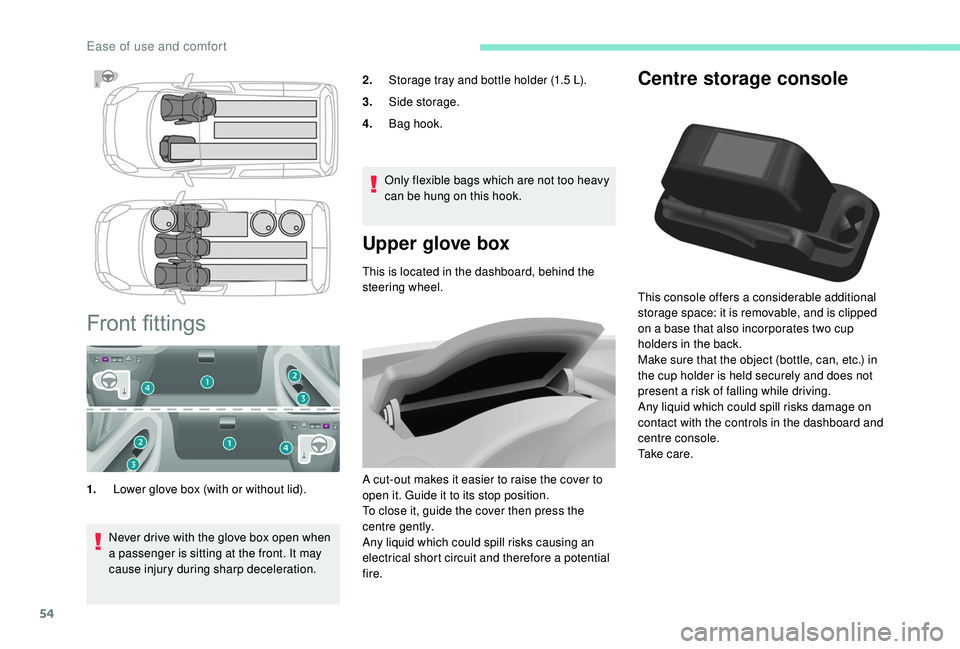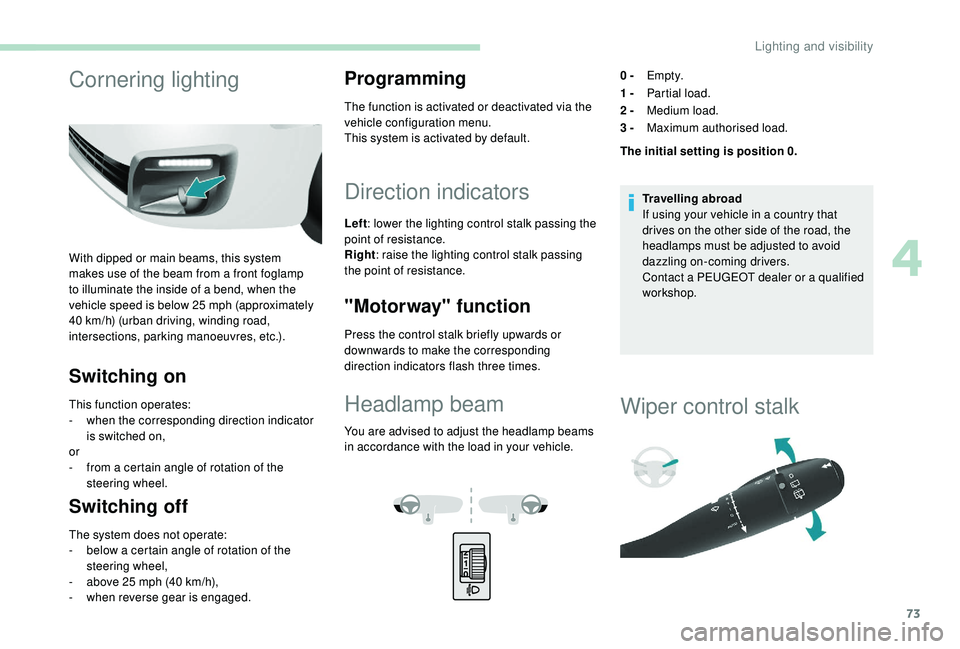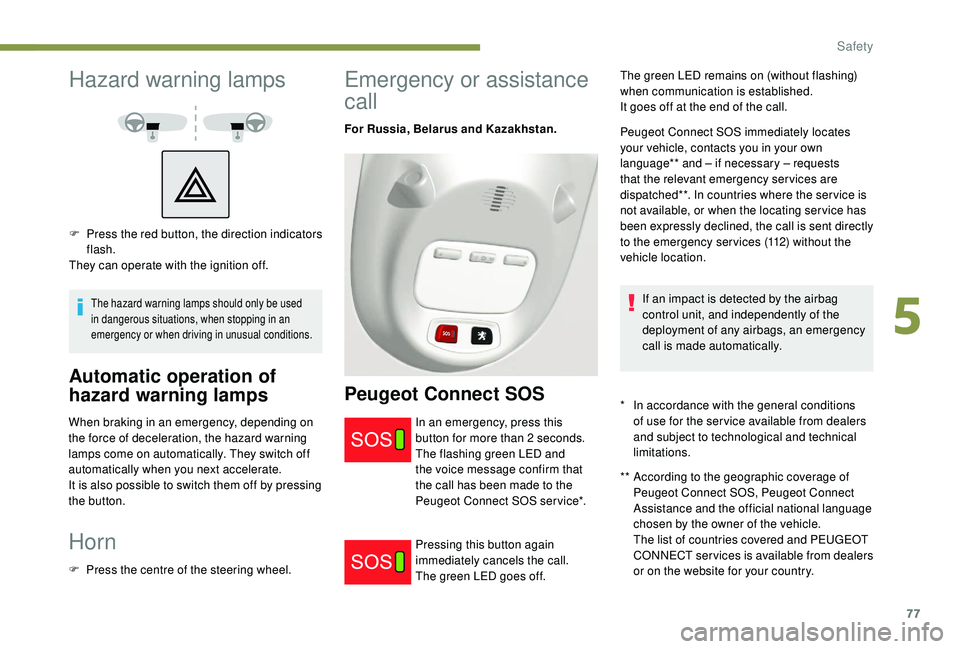2017 PEUGEOT PARTNER TEPEE ELECTRIC steering wheel
[x] Cancel search: steering wheelPage 40 of 252

2
.
.
Instrument panel 7
W arning and indicator lamps 8
I
ndic ators
18
Lighting dimmer
2
2
Trip computer
2
2
Date and time setting
2
3
Instruments and controls
4
K
ey
25
Remote control
2
5
Front doors
2
8
Sliding side door(s)
2
8
Operation in the event of a battery failure
2
9
Tailgate
29
Side-hinged rear doors
3
0
Rear roof flap
3
2
Central locking
3
3
Alarm
34
Rear windows
3
5
Electric windows
3
5Steering wheel adjustment
3
7
Mirrors
37
Surveillance mirror
3
8
Front seats
3
8
Individual passenger seat
4
0
Multi-Flex bench seat
4
0
Rear bench seat
4
2
Rear seats (5 seats) 4 3
Rear seats (7 seats) 4 6
Crew cab
5
0
Seat modularity and configurations
5
2
Front fittings
5
4
Seating area fittings
5
5
Zenith
56
Fragrance diffuser
5
7
Courtesy lamps
5
9
Rear fittings (5 seats)
6
0
Rear fittings (7 seats)
6
1
Load space layout
6
4
Heating/Manual air conditioning
6
6
Dual-zone automatic air conditioning
6
7
Recommendations for ventilation
and air conditioning
6
9
Demisting and defrosting
7
0Lighting control stalk
7
1
Automatic illumination of headlamps
7
2
LED daytime running lamps
7
2
Guide-me-home lighting
7
2
Cornering lighting
7
3
Direction indicators
7
3
Headlamp beam
7
3
Wiper control stalk 7 3
General safety recommendations
7
6
Hazard warning lamps
7
7
Horn
77
Emergency or assistance call
7
7
Anti-lock braking system (ABS/EBFD)
7
9
Emergency braking assistance (EBA)
7
9
Anti-slip regulation (ASR) and electronic
stability control (ESC)
7
9
Grip control
8
0
Seat belts
8
2
Airbags
85
Child seats
8
9
Deactivating the passenger's front airbag
9
0
Reactivating the passenger's front airbag
9
1
Recommended child seats
9
4
Locations for child seats secured using
a seat belt
9
5
ISOFIX mountings and child seats
9
8
Instructions for child seats
1
01
Child lock
1
02
Over view
Instruments
Access Ease of use and comfort
Safety
Lighting and visibility
Eco-driving
Contents
Page 42 of 252

4
Instruments and controls1.Lighting and direction indicator control
stalk.
2. Instrument panel with display.
3. Wiper/screenwash/trip computer control
stalk.
4. Ignition.
5. Audio system controls.
6. Driver's front airbag/horn.
7. Steering wheel height and reach
adjustment.
8. Cruise control/speed limiter controls.
9. Control panel: parking sensors, headlamp
beam adjustment, ESC, Stop & Start,
alarm (depending on country of sale).
10. Bonnet release.
11. Electric door mirror adjustment controls.
12 . Front window controls.
13. Switch panel: hazard warning lamps,
central locking, child lock (depending on
ve r s i o n).
14 . Cigarette lighter.
15. Heating/ventilation controls.
16. Electronic gearbox or Grip control
control.
17. Touch screen.
18. USB port (with electronic gearbox).
19. USB port (with manual gearbox).
Over view
Page 65 of 252

27
Lost keys, remote control
Go to a PEUGEOT dealer, taking with you the
vehicle's registration certificate, your personal
identification documents and if possible, the
label bearing the key code.
The PEUGEOT dealer will be able to retrieve
the key code and the transponder code
required to order a new key.
F
I
nsert the key into the ignition switch with
the remote control buttons (padlocks) facing
you.
F
S
witch on the ignition.
F
W
ithin ten seconds, press the locking
padlock for at least five seconds.
F
S
witch off the ignition.
F
W
ait at least one minute before using the
remote control.
The remote control is now working again. Anti-theft protection
Do not make any modifications to the
electronic engine immobiliser system; this
could cause malfunctions.
For vehicles with an ignition switch, do not
forget to remove the key and turn the steering
wheel to engage the steering lock.
Remote control
The high frequency remote control is a
sensitive system; do not operate it while it is
in your pocket as there is a possibility that
it may unlock the vehicle, without you being
aware of it.
Do not repeatedly press the buttons of your
remote control out of range and out of sight
of your vehicle. You may stop it from working
and the remote control would have to be
reinitialised.
The remote control does not operate when
the key is in the ignition, even when the
ignition is switched off.
Locking the vehicle
Driving with the doors locked may make
access to the passenger compartment by
the emergency ser vices more difficult in an
emergency.
As a safety precaution (with children on
board), remove the key from the ignition or
take the electronic key when you leave the
vehicle, even for a short time. When purchasing a second-hand vehicle
Have the key codes memorised by a
PEUGEOT dealer, to ensure that the keys in
your possession are the only ones which can
start the vehicle.
2
Access
Page 75 of 252

37
Steering wheel adjustment
F While at a standstill, unlock the steering wheel by pulling the control.
F
A
djust the height and reach of the steering
wheel, then lock it by pushing down on the
control.
Mirrors
Adjusting the manual door
mirrors Adjusting the electric door
mirrors
F Move the control to the right or to the left to
select the corresponding mirror.
F
M
ove the control in any of the four directions
to adjust.
F
R
eturn the control to the central position.
Electric folding/unfolding
The mirrors can be folded or unfolded
electrically from the inside, with the vehicle
parked and the ignition on:
F
P
lace the control in the central position.
F
T
urn the control downwards.
F
M
ove the adjustment lever in any of the four
directions to adjust it.
When the vehicle is parked, the door mirrors
can be folded in manually.
They do not have automatic defrosting.
3
Ease of use and comfort
Page 92 of 252

54
Centre storage console
This console offers a considerable additional
storage space: it is removable, and is clipped
on a base that also incorporates two cup
holders in the back.
Make sure that the object (bottle, can, etc.) in
the cup holder is held securely and does not
present a risk of falling while driving.
Any liquid which could spill risks damage on
contact with the controls in the dashboard and
centre console.
Ta k e c a r e .
Front fittings
1.Lower glove box (with or without lid).
Upper glove box
This is located in the dashboard, behind the
steering wheel.
A cut-out makes it easier to raise the cover to
open it. Guide it to its stop position.
To close it, guide the cover then press the
centre gently.
Any liquid which could spill risks causing an
electrical short circuit and therefore a potential
fire.
Never drive with the glove box open when
a passenger is sitting at the front. It may
cause injury during sharp deceleration. 2.
Storage tray and bottle holder (1.5 L).
3. Side storage.
4. Bag hook.
Only flexible bags which are not too heavy
can be hung on this hook.
Ease of use and comfort
Page 111 of 252

73
Cornering lighting
With dipped or main beams, this system
makes use of the beam from a front foglamp
to illuminate the inside of a bend, when the
vehicle speed is below 25
mph (approximately
40
km/h) (urban driving, winding road,
intersections, parking manoeuvres, etc.).
Switching on
This function operates:
- w hen the corresponding direction indicator
is switched on,
or
-
f
rom a certain angle of rotation of the
steering wheel.
Switching off
The system does not operate:
- b elow a certain angle of rotation of the
steering wheel,
-
a
bove 25 mph (40 km/h),
-
w
hen reverse gear is engaged.
Programming
The function is activated or deactivated via the
vehicle configuration menu.
This system is activated by default.
Direction indicators
Left: lower the lighting control stalk passing the
point of resistance.
Right : raise the lighting control stalk passing
the point of resistance.
"Motorway" function
Press the control stalk briefly upwards or
downwards to make the corresponding
direction indicators flash three times.
Headlamp beam
You are advised to adjust the headlamp beams
in accordance with the load in your vehicle. 0 -
Em pt y.
1 - Partial load.
2 - Medium load.
3 - Maximum authorised load.
The initial setting is position 0.
Travelling abroad
If using your vehicle in a country that
drives on the other side of the road, the
headlamps must be adjusted to avoid
dazzling on-coming drivers.
Contact a PEUGEOT dealer or a qualified
workshop.
Wiper control stalk
4
Lighting and visibility
Page 115 of 252

77
Hazard warning lamps
The hazard warning lamps should only be used
in dangerous situations, when stopping in an
emergency or when driving in unusual conditions.
Automatic operation of
hazard warning lamps
When braking in an emergency, depending on
the force of deceleration, the hazard warning
lamps come on automatically. They switch off
automatically when you next accelerate.
It is also possible to switch them off by pressing
the button.
Horn
F Press the centre of the steering wheel.
Emergency or assistance
call
For Russia, Belarus and Kazakhstan.
Peugeot Connect SOS
** According to the geographic coverage of Peugeot Connect SOS, Peugeot Connect
Assistance and the official national language
chosen by the owner of the vehicle.
The list of countries covered and PEUGEOT
CONNECT services is available from dealers
or on the website for your country.
In an emergency, press this
button for more than 2
seconds.
The flashing green LED and
the voice message confirm that
the call has been made to the
Peugeot Connect SOS ser vice*.
Pressing this button again
immediately cancels the call.
The green LED goes off. The green LED remains on (without flashing)
when communication is established.
It goes off at the end of the call.
Peugeot Connect SOS immediately locates
your vehicle, contacts you in your own
language** and – if necessary – requests
that the relevant emergency services are
dispatched**. In countries where the ser vice is
not available, or when the locating ser vice has
been expressly declined, the call is sent directly
to the emergency services (112) without the
vehicle location.
If an impact is detected by the airbag
control unit, and independently of the
deployment of any airbags, an emergency
call is made automatically.
F
P
ress the red button, the direction indicators
flash.
They can operate with the ignition off.
*
I
n accordance with the general conditions
of use for the ser vice available from dealers
and subject to technological and technical
limitations.
5
Safety
Page 124 of 252

86
Front airbags
Activation
The airbags are deployed (except the
passenger's front airbag if it is deactivated)
in the event of a serious frontal impact to all
or part of the frontal impact zone A, in the
longitudinal centreline of the vehicle on a
horizontal plane and directed from the front to
the rear of the vehicle.
The front airbag inflates between the front
occupant of the vehicle and the dashboard, to
cushion their forward movement.
Operating fault
If this warning lamp comes on,
accompanied by an audible warning
and a message on the screen,
contact a PEUGEOT dealer or a
qualified workshop to have the
system checked.
If the two airbag warning lamps remain
on continuously, do not install a "rear ward
facing" child seat, contact a PEUGEOT
dealer or a qualified workshop.
Lateral airbags
This system protects the driver and front
passenger in the event of a severe side impact
in order to limit the risk of injury to the thorax.
These are incorporated in the centre of
the steering wheel for the driver and in the
dashboard for the front passenger(s).
Each lateral airbag is fitted in the front seat's
backrest frame, door side.
Activation
The lateral airbag is deployed on one side in
the event of a severe side impact covering all
or part of side impact zone B, perpendicular to
the longitudinal centreline of the vehicle in a
horizontal plane and directed from the outside
towards the inside of the vehicle.
The lateral airbag inflates between the front
occupant and the corresponding door panel.
Operating fault
If this warning lamp comes on in the
instrument panel, accompanied by an
audible warning and a message on the
screen, contact a PEUGEOT dealer or
a qualified workshop to have the system
checked. The airbags may no longer be
deployed in the event of a serious impact.
In the event of a minor impact or bump on
the side of the vehicle or if the vehicle rolls
over, the airbags may not be deployed.
Safety